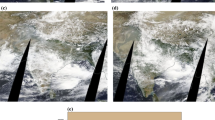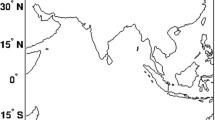Abstract
The accurate predictions of extreme precipitation/snowfall events are very helpful in identifying the severe avalanche/landslide prone hazard areas in advance over high mountainous regions. The Weather Research and Forecasting model (WRF) version 3.9 has been used to investigate the performance of Four-Dimensional Variational data assimilation (4D-Var) on Three-Dimensional Variational data assimilation (3D-Var) by considering two extreme snowfall events (23–26 January 2017 and 05–08 February 2019) over the Western Himalaya (WH). The result shows that the 4D-Var performed better than the 3D-Var for both the events by analyzing domain-averaged error and sensitivity parameter analysis. The initial state model variable’s domain-averaged error analysis revealed that 4D-Var has great potential to improve the initial conditions than the 3D-Var from lower to the upper atmosphere. Sensitivity parameter analysis also supports 4D-Var has more sensitive than the 3D-var especially in the lower and upper atmosphere by changing temperature and moisture fields along with winds circulations. From statistical skill scores analysis, 4D-Var performed well to reproduce the extreme snowfall events than the 3D-Var over WH.














Similar content being viewed by others
References
Andersson, E., Hollingsworth, A., Kelly, G., Lönnberg, P., Pailleux, J., Zhang, Z.: Global observing system experiments on operational statistical retrievals of satellite sounding data. Mon. Weather Rev. 119, 1851–1864 (1991)
Barker, D.M., Huang, W., Guo, Y.R., Bourgeois, A.J., Xiao, Q.N.: A three-dimensional variational data assimilation system for MM5: Implementation and initial results.Mon. Weather Rev. 132(4), 897–914 (2004)
Bonekamp, P.N.J., Collier, E., Immerzeel, W.W.: The impact of spatial resolution, land use, and spinup time on resolving spatial precipitation patterns in the Himalayas. J. Hydrometeorol. 19, 1565–1581 (2018)
Bookhagen, B., Burbank, D.W.: Toward a complete Himalayan hydrological budget: spatiotemporal distribution of snowmelt and rainfall and their impact on river discharge. J. Geophys. Res. Earth Surf. 115, F03019 (2010)
Chevuturi, A., Dimri, A.P.: Investigation of Uttarakhand (India) disaster-2013 using weather research and forecasting model. Nat. Hazards. 82(3), 1703–1726 (2016)
Chen, F., Dudhia, J.: Coupling an advanced land surface hydrology model with the Penn State-NCAR MM5 modelling system, Part I: model implementation and sensitivity. Mon Weather Rev. 129, 569–585 (2001)
Collier, E., Immerzeel, W.W.: High-resolution modeling of atmospheric dynamics in the Nepalese Himalaya. J. Geophys. Res. Atmos. 120, 9882–9989 (2015)
Copernicus Climate Change Service (C3S).: ERA5: Fifth generation of ECMWF atmospheric reanalyses of the global climate. Copernicus Climate Change Service Climate Data Store (CDS, 2017). https://cds.climate.copernicus.eu/cdsapp#!/home
Daley, R.: Atmospheric data analysis. Cambridge Univ. Press, N. Y (1991)
Derber, J.C., Wu, W.S.: The use of TOVs cloud cleared radiances in the NCEP SSI analysis system. Mon. Weath. Rev. 126, 2287–2299 (1998)
Dudhia, J.: Numerical study of convection observed during the winter monsoon experiment using a mesoscale two dimensional model. J. Atmos. Sci. 46, 3077–3107 (1989)
Hong, S.Y., Lim, J.O.J.: The WRF single-moment 6-class microphysics scheme (WSM6). J Korean Meteorological Soc. 42, 129–151 (2006)
Hong, S.Y., Noh, Y., Dudhia, J.: A new vertical diffusion package with an explicit treatment of entrainment processes. Mon. Weather Rev. 134, 2318–2341 (2006)
Huang, X.Y., Xiao, Q., Barker, D.M., Zhang, X., Michalakes, J., Huang, W., Henderson, T., Bray, J., Chen, Y., Ma, Z., Dudhia, J., Guo, Y., Zhang, X., Won, D.J., Lin, H.C., Kuo, Y.H.: Four-dimensional variational data assimilation for WRF: Formulation and preliminary results. Mon. Weather. Rev. 137, 299–314 (2009)
Immerzeel, W.W., Petersen, L., Ragettli, S., Pellicciotti, F.: The importance of observed gradients of air temperature and precipitation for modeling runoff from a glacierized watershed in the Nepalese Himalayas. Water Resour. Res. 50, 2212–2226 (2014)
Ha, J.H., Lim, G.H., Choi, S.J.: Assimilation of GPS Radio Occultation Refractivity Data with WRF 3DVAR and Its Impact on the Prediction of a Heavy Rainfall Event. J. Appl. Met.Clim. 53, 1381–1398 (2014)
Lewis, J.M., Derber, J.C.: The use of adjoint equations to solve a variational adjustment problem with advective constraints. Tellus A. 37A(4), 309–322 (1985)
Kain, J.S.: The Kain-Fritsch convective parameterization: an update. J. Applied. Met. 43, 170–181 (2004)
Kumar, A., Houze, R.A., Rasmussen, K.L., Lidard, C.P.: Simulation of flash flooding storm at the steep edge of the Himalayas. J. Hydrometeorol. 15, 212–228 (2014)
Kumar, M.S., Shekhar, M.S., RamaKrishna, S.S.V.S., Bhutiyani, M.R., Ganju, A.: Numerical simulation of cloud burst event on august 05, 2010, over Leh using WRF mesoscale model. Nat. Hazards. 62, 1261–1271 (2012)
Kumar, P., Shukla, B.P., Sharma, S., Kishtawal, C.M., Pal, P.K.: A high-resolution simulation of catastrophic rainfall over Uttarakhand, India. Nat. Hazards. 80(1134), 1119–1692 (2016)
Liu, C., Schwartz, S., Snyder, C., Ha, S.: Impact of assimilating AMSU-A radiances on forecasts of 2008 Atlantic tropical cyclones initialized with a limited-area ensemble Kalman filter. Mon. Wea. Rev. 140, 4017–4034 (2012)
Lorenc, A. C., Rawlins, F.: Why does 4D-Var beat 3D-Var?. Quart. J. Roy. Meteorol. Soc.131, 613, 3247–3257 (2005)
Maussion, F., Scherer, D., Finkelnburg, R., Richters, J., Yang, W., Yao, T.: WRF simulation of a precipitation event over the Tibetan Plateau, China-An assessment using remote sensing and ground observations. Hydrol. Earth. Syst. Sci. 15, 1795 (2011)
McNally, A.P., Derber, J.C., Wu, W., Katz, B.B.: The use of TOVS level-1b radiances in the NCEP SSI analysis system. Q.J.R. Meteorol. Soc. 126, 689–724 (2000)
Mishra, A.K.: A study on the occurrence of flood events over Jammu and Kashmir during September 2014 using satellite remote sensing. Nat. Hazards. 78(2), 1463–1467 (2015)
Mlawer, E.J., Taubman, S.J., Brown, P.D., Iacono, M.J., Clough, S.A.: Radiative transfer for inhomogeneous atmosphere: RRTM, a validated correlated k-model for the long-wave. J. Geophy. Res. 102, 16663–16682 (1997)
Narasimha Rao, N.R., Shekhar, M.S., Singh, G.P.: Forecasting extreme precipitation event over Munsiyari (Uttarakhand) using 3DVAR data assimilation in mesoscale model. J. Earth. Syst. Sci. 129, 40 (2020)
Norris, J., Carvalho, L.M., Jones, C., Cannon, F., Bookhagen, B., Palazzi, E., Tahir, A.A.: The spatiotemporal variability of precipitation over the Himalaya: Evaluation of one year WRF Model simulation. Climate Dyn. 49, 2179–2204 (2017)
Orr, A., Listowski, C., Couttet, M., Collier, E., Immerzeel, W., Deb, P., Bannister, D.: Sensitivity of simulated summer monsoonal precipitation in Langtang Valley, Himalaya to cloud microphysics schemes in WRF. J.Geophys.Res.Atmos. 122, 6298–6318 (2017)
Parrish, D.F., Derber, J.C.: The national meteorological center’s spectral statistical-interpolation analysis system. Mon. Weather Rev. 120, 1747–1763 (1992)
Rasmussen, K.L.R., Houze, R.: A flash-flooding storm at the steep edge of high terrain: disaster in the Himalayas. B. Am.Meteorol. Soc. 93, 1713–1724 (2012)
Routray, A., Mohanty, U.C., Osuri, K.K., Kar, S.C., Niyogi, D.: Impact of satellite radiance data on simulations of bay of Bengal tropical cyclones using the WRF-3DVAR modeling system. IEEE. Trans.Geosci. Remote. Sens. 54(4), 2285–2303 (2016)
Sikka, D.R., Ray, K., Chakravarthy, K., Bhan, S.C., Tyagi, A.: Heavy rainfall in the Kedarnath valley of Uttarakhand during the advancing monsoon phase in June 2013. Curr. Sci. 109, 2353–2361 (2015)
Shekhar, M.S., Chand, H., Kumar, S., Ganju, A.: Climate-change studies in western Himalaya. Ann. Glaciol. 51, 105–112 (2010)
Shekhar, M.S., Pattanayak, S., Mohanty, U.C., Paul, S., Kumar, M.S.: A study on the heavy rainfall event around Kedarnath area (Uttarakhand) on 16 June 2013. J. Earth. Syst. Sci. 124(7), 1531–1544 (2015)
Shi, J.J., Tao, W.-K., Matsui, T., Cifelli, R., Hou, A., Lang, S., Tokay, A., Wang, N.-Y., Peters-Lidard, C., Skofronick-Jackson, G., Rutledge, S., Petersen, W.: WRF simulations of the 20–22 January 2007 snow events over eastern Canada: comparison with in situ and satellite observations. J. Appl. Meteor. Climatol. 49, 2246–2266 (2010)
Thepaut, J.N., Courtier, P., Belaud, G.: Lematre,G.: Dynamical structure functions in a four-dimensional variational assimilation: A case study. Quart. J. Roy. Meteorol. Soc. 122(530), 535–561 (1996)
Wee, T.K., Kuo, Y.H., Bromwich, D.H., Monaghan, A.J.: Assimilation of GPS radio occultation refractivity data from CHAMP and SAC-C missions over high southern latitudes with MM5 4DVAR. Mon. Wea. Rev. 136, 2923–2944 (2008)
Whiteman, C.D.: Mountain meteorology: fundamentals and applications. Oxford University Press. (2000)
Wilks, D.S.: Statistical Methods in the Atmospheric Sciences, 3rd edn, p. 676. Elsevier (2011)
Zapotocny, T.H., Jung, J.A., Marshall, J.F.L., Treadon, R.E.: A two-season impact study of four satellite data types and rawinsonde data in the NCEP global data assimilation system. Weather Forecast. 23, 80–100 (2008)
Zhou, H., Gómez-Hernadez, J.J., Hendricks Franssen, H.J., Li, L.: An approach to handling nongaussianity of parameters and state variables in ensemble kalman filtering. Adv. Water. Re-sour. 34, 844–864 (2011)
Zhang, X., Huang, X.Y., Liu, J.: Development of an efficient regional four-dimensional variational data assimilation system for WRF. J. Atmos. Ocean. Technol. 31(12), 2777–2794 (2014)
Zhang, X., Huang, X.Y., Pan, N.: Development of the upgraded tangent linear and adjoint of the Weather Research and Forecasting (WRF) Model. J. Atmos. Ocean. Technol. 30(6), 1180–1188 (2013)
Acknowledgments
Authors are thankful to Director, SASE for providing full support and NCAR for using the WRF model. The authors would also like to acknowledge the NCEP GFS 0.25 Degree Global Forecast data used here as the initial and boundary conditions for the model archived from the Research Data Archive (RDA), National Center for Atmospheric Research (NCAR). NCAR is sponsored by the National Science Foundation (NSF), USA. TRMM and GPM used in this study are produced with the Giovanni online data system, developed and maintained by the NASA GES DISC.
Author information
Authors and Affiliations
Corresponding author
Additional information
Responsible Editor: Dong-Hyun Cha.
Publisher’s Note
Springer Nature remains neutral with regard to jurisdictional claims in published maps and institutional affiliations.
Appendices
Appendix −1
1.1 Contingency Table (2 X 2)
Observed | ||||
|---|---|---|---|---|
Forecasted | Yes | No | ||
Yes | Hits (a) | False Alarm (b) | (a + b) Forecasted Yes | |
No | Misses (c) | Correct negatives (d) | (c + d) Forecasted No | |
(a + c) Observed Yes | (b + d) Observed No | Total (N) | ||

Statistical Scores.
1. Accuracy (Acc)
Acc = \( \frac{a+d}{N}=\frac{Correct\ Forect}{Total\ Events.} \)
Range: 0 to 1. Perfect score: 1.
2. Bias Score (Bias) =\( \frac{a+b}{a+c}=\frac{Forecasted\ events}{Observed\ Events} \)
Range: B = 1 Unbiased, B > 1 under Forecast, B < 1 Over Forecast
3. Probability of Detection (POD)
\( \left( POD=\right)\frac{a}{a+c}=\frac{Hits}{Observed\kern0.5em Events\kern0.5em \left(\mathrm{yes}\right)} \)
Range: 0 to 1. Perfect score: 1.
4. False Alarm Ratio (FAR)
\( \left( FAR=\right)\frac{b}{a+b}=\frac{False\kern0.5em Alarm}{Forecasted\kern0.5em Events\kern0.5em \left(\mathrm{yes}\right)} \)
Range: 0 to 1. Perfect score: 0.
5. Equitable Threat Score (Gilbert Skill Score; ETS)
hits_random = HR = \( \frac{\left(a+c\right)\left(a+b\right)}{N} \)
ETS = \( \frac{a- HR}{\left(\left(a+b+c\right)- HR\right)} \)
Range: −1/3 to 1, 0 indicates no skill. Perfect score: 1.
6. Heidke Skill Score (HSS)
\( \left( HSS=\right)\frac{2\ast \Big(\left(a\ast \mathrm{d}\right)-\left(\mathrm{b}\ast \mathrm{c}\right)}{\left(\left(a+c\right)\ast \left(\mathrm{a}+\mathrm{b}\right)\ast \left(\mathrm{b}+\mathrm{d}\right)\right)} \)
Range: −1 to 1, 0 indicates no skill. Perfect score: 1.
7. Mean Absolute Error (MAE)
\( \left( MAE=\right)\frac{1}{N}{\sum}_{i=1}^N\mid {F}_i-{O}_i\mid \)
8. Root Mean Square Error (RMSE)
\( \left( RMSE=\right)\sqrt{\frac{1}{N}{\sum}_{i=1}^N{\left({\mathrm{F}}_{\mathrm{i}}-{\mathrm{O}}_{\mathrm{i}}\right)}^2} \)
Rights and permissions
About this article
Cite this article
Nalamasu, N., Shekhar, M.S. & Singh, G. Performance of 4D-Var Data Assimilation on Extreme Snowfall Forecasts over the Western Himalaya Using WRF Model. Asia-Pacific J Atmos Sci 57, 555–571 (2021). https://doi.org/10.1007/s13143-020-00216-z
Received:
Revised:
Accepted:
Published:
Issue Date:
DOI: https://doi.org/10.1007/s13143-020-00216-z




